The most powerful telescopes you can buy to use at home are 10 to 16-inch aperture telescopes.
Aperture is the best measure of a telescope’s power – the bigger this is, the better the views you will have.
There are two main types of telescope that you can buy of this size – Dobsonians and Schmidt-Cassegrains – each with their pros and cons.
There are also smart telescopes, for amazingly easy astrophotography.
See below our quick picks or read on for more detail.
|
Aperture:
14-inch
|
Aperture:
16-inch
|
Aperture:
12-inch
|
Aperture:
6-inch
|
|
Type:
Schmidt-Cassegrain
|
Type:
Dobsonian Reflector
|
Type:
Dobsonian Reflector
|
Type:
Schmidt-Cassegrain (RASA)
|
|
GOTO:
Yes
|
GOTO:
Yes
|
GOTO:
No
|
GOTO:
Yes
|
|
Weight:
210 lbs
|
Weight:
177 lbs
|
Weight:
83 lbs
|
Weight:
42 lbs
|
|
Pros:
|
Pros:
|
Pros:
|
Pros:
|
|
Cons:
|
Cons:
|
Cons:
|
Cons:
|
- Great for observing and astrophotography
- CGX-L German Equatorial Mount excels for astrophotography
- GOTO technology finds objects in space at the press of a button
- Very heavy
- Huge aperture - the most powerful home telescope you can buy
- Computerized GOTO auto tracking system finds objects for you
- Collapsible design for storage
- Bulky and heavy
- Not great for astrophotography
- Easy to use and great for beginners
- No GOTO means no cables or power source needed
- Great value price
- Bulky and heavy
- Not great for astrophotography
- All-in-one package that takes astrophotography images for you at the press of a button from your smartphone
- The best smart telescope for imaging
- Not for looking through (no eyepiece)
You can also watch our video on this topic:
Dobsonians – Big & Bulky, But Great Value
The first option is go for a 10 to 16-inch Dobsonian telescope:
- These are the best value in terms of price-to-aperture, i.e. they are cheaper than Schmidt-Cassegrains for the same power
- But they are extremely big, bulky and heavy
- They are great for astronomy/observing but not so good for astrophotography (although it can be done, even with a smartphone)
Therefore these are best for those that have space at home to store and use, and are more interested in observing than getting into advanced astrophotography.
Recommended models available to buy in this category right now are:
- Sky-Watcher 16″ GOTO Collapsible Dobsonian – the biggest you can get
- Sky-Watcher 14″ GOTO Collapsible Dobsonian
- Celestron Starsense Explorer 12″ Dobsonian – great for beginners as it uses your smartphone to guide you
- Sky-Watcher 12″ GOTO Collapsible Dobsonian
- Sky-Watcher 12″ Collapsible Dobsonian
- Celestron Starsense Explorer 10″ Dobsonian
- Sky-Watcher 10″ Collapsible Dobsonian
As I already said, the bigger the aperture the better the views, but also the bigger physically it will be and the more expensive it will be.
The other differences between these telescopes are:
- GOTO or Manual: “GOTO” means your telescope is computerized and will find objects in the night sky for you at the press of a button. This is great but costs more and needs a power source. Manual Dobsonians are cheaper and don’t need cables/batteries, but you will need to find the astronomical objects to look at yourself.
- Starsense Explorer: Celestron offers an alternative to GOTO with these telescopes where you attach your smartphone to the telescope. You then use an app to scan the night sky and it then guides you to things to see. This is simpler than GOTO and you don’t need a power source but you are manoeuvring it by hand and it won’t track objects.
- Collapsible or Classic: Collapsible models feature a main telescope tube that folds down to reduce it’s size when in storage. This is good to have but increases cost.
Schmidt-Cassegrains – More Compact & Great for Astrophotography
The other option is to buy an 11 or 14-inch Schmidt-Cassegrain telescope (SCT):
- These are smaller and more compact
- Are great for astrophotography
- But are more expensive
Recommended models available to buy in this category are:
14-inch aperture:
11-inch aperture:
To understand the differences:
- Mount: CPC, CGX and CGX-L indicates the mount included in the package:
- CPC is easiest to use and doesn’t use heavy counterweights
- The CGX and CGX-L are better for astrophotography.
- The CGX-L has the highest capacity but the CGX is enough for the 11-inch Celestron telescope tube
- HD: “HD” indicates the telescope tube (OTA) is astrophotography-optimized for those that want to pursue more advanced deep sky imaging. Therefore:
- The Celestron CPC 1100 and Celestron CGX-L 11 are the same telescope (OTA) with a different mount
- The Celestron CPC 1100 HD and Celestron CGX 1100 HD are the same telescope (OTA) with a different mount
Recommended Models
A good recommendation for a beginner is the Celestron CPC 1100.
This is a complete package and can excel for both astronomy and astrophotography, as well as being relatively easy to use.
Celestron CPC 1100 StarBright XLT GPS Schmidt-Cassegrain Telescope with Tripod
- Huge 11-inch aperture for amazing views
- All you need in one package, with telescope, mount, and tripod
- Computerized mount finds objects for you to view at a press of a button
If you want maximum power and more advanced astrophotography capacity then for either the Celestron CGX-L 1400
14-inch Celestron Schmidt-Cassegrain Telescope & Mount
- Most powerful Celestron Telescope
- High aperture gives you great views
- CGX-L German Equatorial Mount excels for astrophotography
- GOTO technology finds objects in space at the press of a button
Or the Celestron CGX-L 1400 EdgeHD.
14-inch EdgeHD Schmidt-Cassegrain Telescope & Mount
- Most powerful Celestron Telescope
- High aperture gives you great views
- EddeHD telescope technology elevates deep sky astrophotography capacity
- CGX-L German Equatorial Mount excels for astrophotography
- GOTO technology finds objects in space at the press of a button
If you want the very biggest for observing (not astrophotography), then the Sky-Watcher 16-inch GOTO Dobsonian is for you.
- Huge 16-inch Aperture - the most powerful home telescope you can buy
- Computerized GOTO auto tracking system finds objects for you
- Collapsible design for storage
- Superb value for money
Finally, best for beginners is the easy-to-use Celestron Starsense Explorer 12″ Dobsonian.
Smartphone app-Enabled Dobsonian Telescope
- Huge 12-inch aperture
- Easy to use and great for beginners
- No GOTO means no cables or power source needed
- Great price-to-aperture value
- Bulky and heavy
- Not great for astrophotography
This smartphone-interactive telescope guides you to find and view objects in the night sky.
Alternatively, if you want the most powerful smart telescope, then the Celestron Origin Mark II is where you should look but is astrophotography only.
Brand new smart telescope from Celestron in 2025
- Large 6-inch aperture RASA astrophotography telescope
- Fast f/2.2 focal ratio
- 8.3 MP camera
- All-in-one package that takes astrophotography images for you at the press of a button from your smartphone
- The best smart telescope for imaging
- Weighs over 19 kg / 40 lbs
If you want a powerful smart telescope with an eyepiece to look through then your options are the Unistellar Evscope 2 or the Unistellar Odyssey Pro.
Premium Smart Telescope with Eyepiece
- Eyepiece allows realtime viewing
- Control with your smartphone via app
- Join Citizen Astronomy networks and help detect near-earth asteroids
- May need occasional adjustment (collimation)
Premium Smart Telescope
- Easy to use and perfect for complete beginners
- Features eyepiece for live viewing of the night sky
- Portable with a compact size and light weight
- Lower spec than premium alternatives
- Premium price
Read on for a more detailed analysis and explanation.
Most Powerful Telescopes You Can Buy
Celestron CPC 1100
Great All-Round Option
This is an 11-inch aperture catadioptric GOTO telescope package from Celestron (the best telescope manufacturer in my opinion).
The Celestron CPC 1100 makes our top pick for a number of reasons:
- Great all around for observing and astrophotography
- Easy to use with the GOTO fork mount
- Made by Celestron – the best consumer telescope manufacturer
- Relatively affordable compared to other options
With this, you get a powerful 11-inch aperture telescope in an all-in-one package.
The advantage of this is that you get the big power for great views but in a relatively compact package and for a reasonable price (note though that all of these most powerful telescopes are big, and none are cheap).
It includes a GOTO (computerized) mount, which means that it finds objects for you to look at at the press of a button on the handset (or via a downloadable smartphone app).
It is easy to use and much less bulky and cumbersome than a Dobsonian or equatorial mount.
It is fairly compact in size given the large aperture and it is easy to operate and so suits someone looking for the best there is to buy straight out of the box.
It can be used for astrophotography, and the long focal length SCT design is especially good for planetary photography.
The downsides to consider for this telescope are :
- It has less aperture (power) than a 16-inch Dobsonian
- It is less tailored for astrophotography than the HD/CGX version (see below)
- Whilst the SCT design is compact, it is still pretty big and heavy
You can watch this video for an overview of the CPC telescope range:
Overall, this is a great option if you just want to go straight for a great all-round – but very powerful – telescope that you can use at home with little complication.
You have all you need in one package, it is simple to use, and is premium quality in terms of the Celestron telescope and mount included.
Key specifications
- Type: Catadioptric (Schmidt-Cassegrain)
- Aperture: 11-inch / 279 mm
- Focal length: 110-inch / 2800 mm
- Focal ratio: F/10
- Mount: Celestron CPC Computerized (GoTo) Fork Mount
Celestron CPC 1100 StarBright XLT GPS Schmidt-Cassegrain Telescope with Tripod
- Huge 11-inch aperture for amazing views
- All you need in one package, with telescope, mount, and tripod
- Computerized mount finds objects for you to view at a press of a button
Celestron CPC Deluxe 1100 HD
Excels for Astrophotography
This Celestron CPC Deluxe 1100 HD is our recommendation as the most powerful home telescope if you want the best for astrophotography.
This is the same package in terms of the GOTO CPC mount, but with the Edge HD version of the 11-inch telescope tube that is optimized for photographing deep sky objects like galaxies.
To explain, the Celestron telescope OTAs come in three main types:
- Standard OTAs like that included in the CPC 1100 above. These great all-rounders for both astronomy and astrophotography
- EdgeHD versions like this one. More tailored for advanced astrophotography but are more expensive
- RASA versions. These have shorter focal lengths and are specialized for deep sky astrophotography but are note suited for observing
Therefore, if you want something that has a greater capacity for advanced astrophotography – and you have the budget – then we recommend this model.
Whilst it is also an 11-inch Celestron SCT, it differs from the CPC 1100 above in three specific ways:
- The telescope tube has been optimized for deep-sky astrophotography with the EdgeHD correcting for distortion (coma) that can occur around the edge of images
- The telescope can be adapted with the Fastar technology to massively speed up the focal ratio and better collect light for imaging
It comes at a higher price, but if you think you want to get into photographing planets, galaxies and other far-off objects then this might be for you.
This EdgeHD optics correct for field curvature and coma that occur in Schmidt-Cassegrain telescopes. This makes it improved for viewing or photographing wide-field deep sky objects.
The telescope has a focal ratio of f/10 but there is the functionality to remove the secondary mirror so that a camera can be attached directly (Celestron call this Fastar technology). This dramatically increases the focal ratio to f/2 to make it better for astrophotography.
These features make it excel for astrophotography and our analysis shows it is one of the most successfully used telescopes in astrophotography competitions.
Having said that though, this is not solely a telescope for astrophotography (known as an astrograph), but also can be used for visual astronomy and observing.
The cons of this package are:
- It is more expensive than the non-HD package above or a big dobsonian
- It has less aperture (power) than a 14 or 16-inch Dobsonian
- Whilst the SCT design is compact, it is still a big and heavy telescope
This video from Trevor at AstroBackyard features him using this telescope for astrophotography:
Overall, this is the best option if you want the biggest home telescope that can excel for astrophotography.
Key specifications
- Type: Catadioptric (Schmidt-Cassegrain)
- Aperture: 11-inch / 279 mm
- Focal length: 110-inch / 2800 mm
- Focal ratio: F/10 as standard but F/2 when adapted with Fastar
- Mount: Celestron CPC Computerized (GoTo) Fork Mount
Celestron CPC 1100 EdgeHD Schmidt-Cassegrain Telescope with Tripod
- Huge 11-inch aperture optimized for astrophotography
- All you need in one package, with telescope, mount, and tripod
- Computerized mount finds objects for you to view at a press of a button
- Used by Stephen Hawking
Sky-Watcher 16-inch GOTO Collapsible Dobsonian
Big on Aperture, Big on Size
Finally, if you really want the biggest power then this Sky-Watcher 16-inch Dobsonian might be for you:
This is really the highest power you can buy off the shelf and will give you AMAZING views, but there are two many caveats that I would flag for this:
- It is physically huge and bulky – you need to make sure you have the space to use and keep it
- It is great for astronomy – i.e. sitting out and looking at the planets and other sights – but it is not great for astrophotography. It can be done, but it is just not what it is designed for.
This is actually the most powerful telescope you can buy. 14-inch aperture is huge and the highest you will get for a consumer telescope you can buy off the shelf.
The Dobsonian design is also the best bang-for-buck in that it gives you a huge aperture at a much cheaper cost than the Schmidt-Cassegrain models recommended above.
The reason that this is third in our list rather than first is that the Dobsonian design is not suited to everyone:
- Firstly, it is physically huge – over six feet tall and also as heavy as a grown adult
- It is perfect for observing, but less so for astrophotography and most people want to dabble in imaging with their telescopes
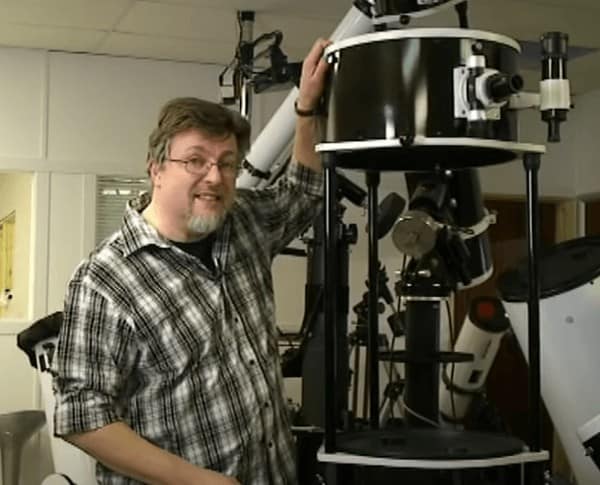
The collapsible tube does mean that although it is very large, it can shrink down for easier storage, but it is still big.
See this telescope’s Synscan GOTO functionality in action here:
Overall, if you have the space at home to use and store a telescope like this then this is a great option as you get an extremely powerful telescope for a relatively low cost.
It is most suited to those that want to have observing sessions in their backyard, taking their time to view objects in real time through the high aperture optics.
Key specifications
- Type: Dobsonian Reflector
- Aperture: 16-inch / 4.6 mm
- Focal length: 71-inch / 1800 mm
- Focal ratio: F/4.4
- Mount: Synscan Computerized (GoTo) Dobsonian
- Huge 16-inch Aperture - the most powerful home telescope you can buy
- Computerized GOTO auto tracking system finds objects for you
- Collapsible design for storage
- Superb value for money
Celestron StarSense Explorer 12″ Dobsonian
Newly released in 2023, this 12-inch Dobsonian is perfect for beginners who want maximum power but also in an affordable package that is easy to use.
Rather than a GOTO/computerized base, it utilizes Celestron’s Starsense Explorer technology. With this, you effectively use your smartphone as a budget computer. It scans the night sky and tells you what you can view tonight from your location:
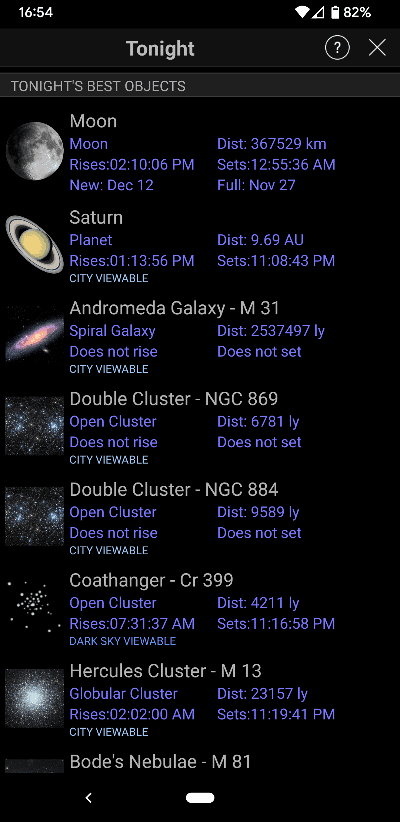
Then you can select and object and it will guide you to it:
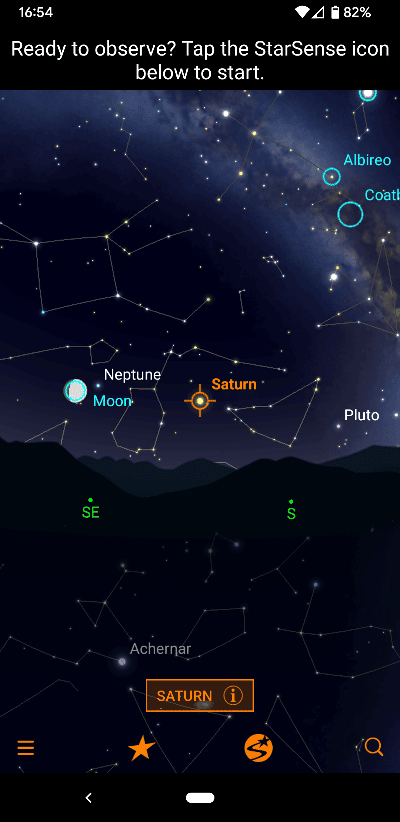
This means you are doing it manually but it is very easy and also you don’t have to deal with cables or another power source for a GOTO mount, which can make it much more convenient.
The downsides of this telescope are, like the models above, the physical size. You can see from this image how large it stands next to Erik from Celestron:
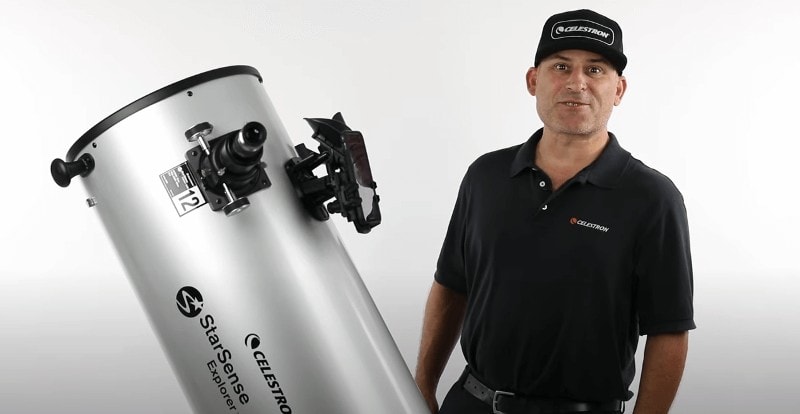
Overall, this is a great option for beginners or a stargazer of any level that wants high power in a convenient package.
Key specifications
- Type: Dobsonian Reflector
- Aperture: 12-inch / 305 mm
- Focal length: 59-inch / 1500 mm
- Focal ratio: F/4.7
- Mount: Manual Dobsonian
Smartphone app-Enabled Dobsonian Telescope
- Huge 12-inch aperture
- Easy to use and great for beginners
- No GOTO means no cables or power source needed
- Great price-to-aperture value
- Bulky and heavy
- Not great for astrophotography
Most Powerful Home Telescope Buying Guide
With going for the most powerful telescope you can buy you really have two broad choices in terms of telescope type, each with their pros and cons:
- Schmidt-Cassegrain Telescopes (SCT):
- Great all-rounders that excel for both astronomical observing (i.e. looking through) and astrophotography (taking photos).
- Relatively compact compared to dobsonian telescope types of similar aperture and so easy to manage and store.
- However, they are more expensive in terms of price-to-power (aperture)
- Dobsonian Reflectors:
- Great value for money in that a 12-inch Dobsonian may cost a quarter of that of a 11-inch SCT
- Great for astronomical observing (i.e. looking through), however they are not ideal for astrophotography.
- They are extremely large and bulky – literally bigger than a grown man, and so you have to make sure you have the space to store and use it
Within these categories you then have a number of other choices like:
- GOTO or manual – Most would prefer GOTO auto tracking but a manual Dobsonian just for observing can be a great way of getting big power at a low price
- Mount type – Equatorial mounts are better for astrophotography but are more cumbersome and heavy than fork mounts
- OTA type – the telescope tubes can come in different versions with some more optimized for astrophotography than others
SCTs – The Most Powerful Celestron Telescopes
SCTs the best option if you want something that you can easily setup up at home and get running quickly.
They are a type of catadioptric (or compound) telescope. This refers to a category of telescope which is essentially a mix of the two main telescope types – reflectors and refractors.
All you really need to know as a buyer is that this makes them much smaller and less bulky, whilst retaining the power and viewing capabilities. The downside is that they are more expensive.
The alternative to buying one of the packages above is to buy the standalone OTA and then build your own package with a separate mount:
- Celestron C14 OTA
- Celestron EdgeHD 14 OTA
- Celestron C11 OTA
- Celestron EdgeHD 11 OTA
- Celestron RASA 11-inch
You can then buy the Celestron CGX-L mount separately or you could explore alternative mounts – see our guide to the best mounts for astrophotography.
The advantage of buying standalone OTA is that with careful shopping around and patience you may be able to save money by buying different parts separately and cheaper over time.
The downside is that you won’t have an all-in-one package you can just open up at home, and it requires a fair bit more research in buying all the component parts you need and making them work together.
Dobsonian Telescopes
Finally, dobsonians offer the best bang-for-buck in terms of power to price and can be substantially cheaper than the compound telescope packages covered above.
However, they are huge and bulky (sometimes perhaps 6ft tall), therefore requiring a suitable space to store and use them, which might not work for everyone.
They are also harder to learn and master how to use and so are more for the most enthusiastic astronomers.
Sky-Watcher offers the most popular Dobsonian models. See the table above for what is available now.
The Very Biggest Telescopes You Can Buy
In addition, to these “regular” telescopes above that can be bought off-the-shelf, there are even bigger telescopes from specialist manufacturers for advanced users.
25-inch: Obsession Classic Dobsonian
We now move on to the specialist telescope manufacturers.
The first that we come across is the 25-inch aperture Classic Dobsonian from the manufacturer Obsession. These are custom-built for buyers and will set you back in the region of $19,995.
These large Dobsonian telescopes start to get pretty massive in terms of height and bulk. Some of them require the use of ladders to look through the eyepiece.
32-inch: Webster C32 f/3.6
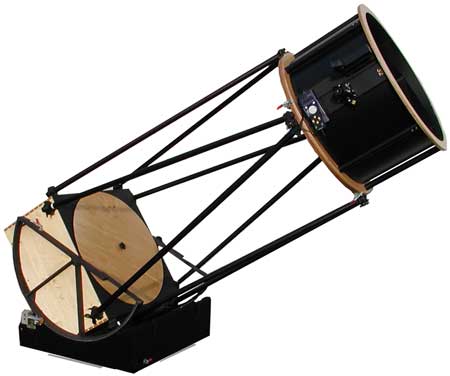
Even bigger is this 32-inch aperture telescope from Webster. It stands 118-inches (299cm) tall, although Webster boasts that it can be easily moved about by one person.
It is on wheels and, when tilted, it can slide through doorways, thereby suiting storage in a garage.
We spoke to Webster and they say that in recent years they have built 53-inch and 40-inch aperture telescopes for customers and that they can build anything up to 60-inches.
They also informed me that they once heard about a 73-inch aperture telescope being built in New Mexico but don’t know if it was ever finished!
Here’s a picture of a 28-inch Webster telescope:
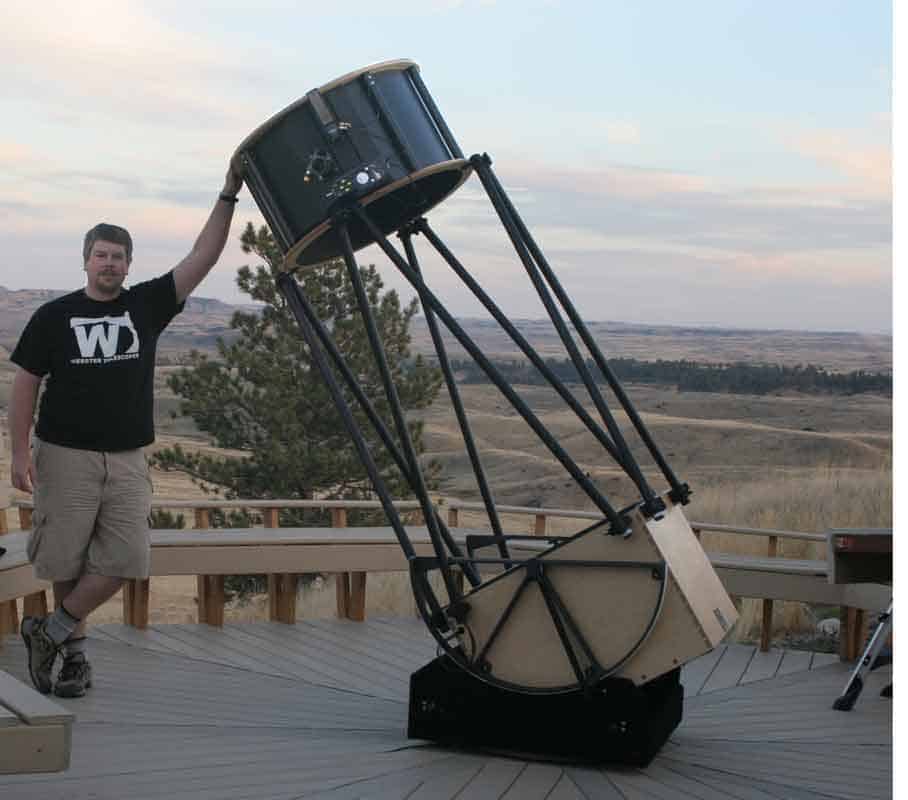
40-inch: Planewave 1 Meter Observatory Telescope
Next up is this 40-inch (1-meter) aperture telescope from Planewave.
This is a bit different as it is designed for use in an observatory and not for home use.
In the video below you can see the documented process of installing one of these telescopes in an observatory in Chile:
50-inch: New Moon Big Guy
We now get to the 50-inch “Big Guy” telescope from New Moon.
Again, these are huge constructions and one of these will set you back a cool $175k.
65-inch: Optiques Fullum
Lastly, the biggest telescope we could find was this 65-inch aperture model from the Canadian manufacturer Optiques Fullum.
How to assess telescope power? It’s all about aperture
The best indicator of the power of a telescope is its aperture.
Aperture is the measure of how wide the lens of the telescope is.
The wider (larger) the aperture, the more light it gathers, and the better images you will see (and photograph, if you wish).
Beginner’s telescopes might have apertures between 2 and 8 inches (60 – 200 mm).
These can work well for casual viewing and will allow you to see the planets of the solar system, other objects in the night sky, and but deep-sky objects like galaxies and nebulae may remain faint and hard to see.
Advanced telescopes from leading retail telescope manufacturers (Celestron and Sky-Watcher) will then range from 10 to 14-inch. These will give much-improved viewing and brighter, clearer images.
The general rule though is that the higher the aperture, the higher the cost of the telescope.
There are other factors that influence this though, and you will see from reading on that you can get higher aperture telescopes for less money if you are able to handle something that is less user-friendly and extremely large in size.
After this, there are specialist telescope brands and retailers who sell giant and customized telescopes with apertures in the range of 50-60 inches. These can be huge and powerful and are generally more for the advanced telescope user.
See below for profiles of giant telescopes from companies like Obsession, Webster and New Moon. These are big beasts! There are some videos included in this article that you can watch to get a good idea of their size.
Limiting magnitude
There is another, more complicated measure of a telescope’s power, known as its limiting magnitude. This is a measure of the farthest object that you will be able to see with a telescope.
See here for a calculator that enables you to work out this figure for any telescope. For the sake of simplicity, we stick to aperture as the best measure of power in this article.
Conclusion: The Most Powerful Telescope You Can Buy
We went on a quest to find the most powerful telescope you can buy.
What we found is that these range from very powerful but regular-sized telescopes, to the ridiculously large bigger-than-a-person model.
If you are looking for the most powerful telescope you can buy off the shelf to use at home, then it’ll be a 10 to 16-inch SCT or Dobsonian.
This is more or less the biggest size you’ll get from the major telescope retailers before you start getting into models suitable only for observatories.
None of the telescopes in this article are what any normal person would regard as “cheap”. In fact, they can range from the price of a vehicle to the price of a house. If you want to see some cheaper options, then check out the best telescopes for beginners and for intermediate users.
If you still can’t decide then my tips are:
- If you’ve got the money and want the best of the best, then you should go for a Celestron SCT with as large aperture as you can afford. If you want to be doing astrophotography then consider an option with an equatorial mount and an optimized OTA like the Celestron EdgeHD or RASA models
- If you don’t have the budget for this but want maximum power, then a Dobsonian would be the right choice for you.
Just remember to consider the weight and size of the telescope to make sure that you have the space to enjoy it. With the Dobsonians, you will need a garage or somewhere similar to store them as they are man-sized and these will not suit the casual user.
If you really want a huge specialist telescope, then do some good research into the size and portability and think about how you will use it. It’ll probably be worth it – some of these telescopes cost as much as a house, so obviously be sure about what you are doing.




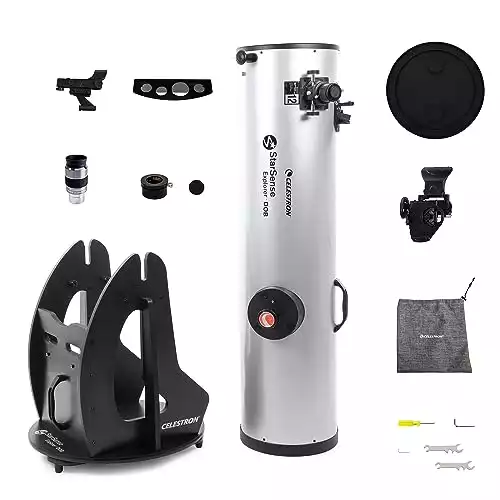








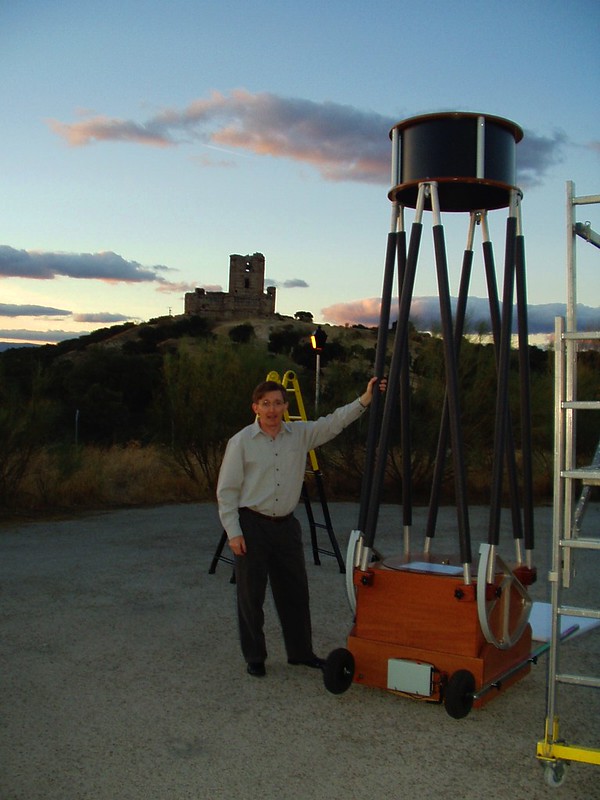
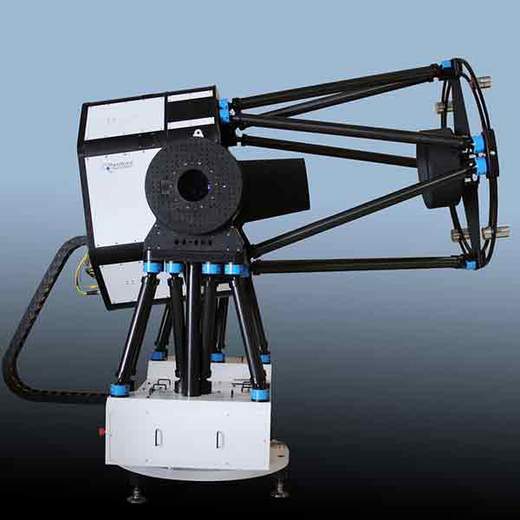

Very good article! Gives great information that is normally hard to find, in one place, on the internet. Guess who I will be following. Thank you so much Anthony!
Thank you so much Benjamin!